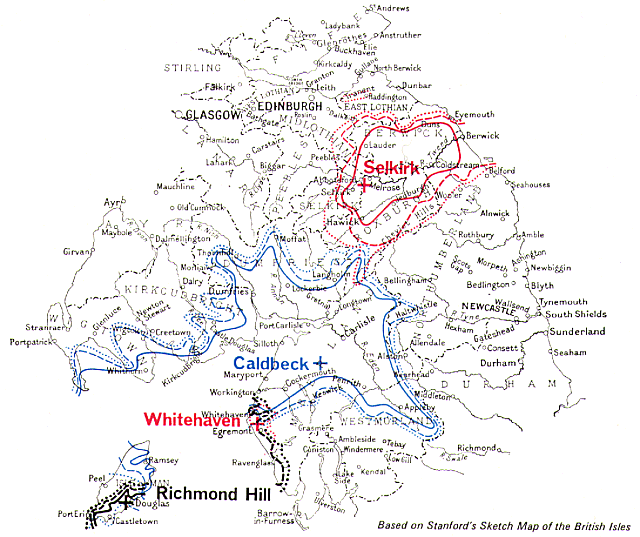 |
UK Broadcast Transmission |
|
|||||||||||
ITV 405 line VHF TV TRANSMITTERS
THE BORDERS AND THE ISLE OF MAN
| CALDBECK | SELKIRK | Richmond Hill | Whitehaven | |
| Channel / Polarisation | 11 H | 13 V | 8 H | 7 V |
| Max. Vision ERP | 100 kW | 25 kW | 10 kW | 0.1 kW |
| Site ASL | 947 ft | 944 ft | 542 ft | 436 ft |
| Aerial ASL | 1902 ft | 1644 ft | 730 ft | 571 ft |
| Location (NGR) | NY 299425 | NT 502296 | SC 335748 | NX 992123 |

The Authoritiy's Borders area was served by four of the ITA's VHF transmitting stations Selkirk, Caldbeck in Cumberland; Richmond Hill in the Isle of Man; and a relay station near Whitehaven in Cumberland. The Border country has two well-populated areas separated by the high sparsely-populated Cheviot Hills. Studies showed the best way of serving the populated areas was to build two separate stations, one near Carlisle and one near Selkirk. The site chosen for the first station was at Caldbeck, 947 ft above sea level and some 10 miles south-west of Carlisle in the foothills of the Cumbrian Mountains. Caldbeck lies somewhat to the south of the area to be served and a directional transmitting aerial supported on a 1,000 ft mast was provided to radiate the maximum power of 100 kW to the north-east and the south-west, about 70 kW to the north-west across the Solway Firth, but only 20 kW to the south-east. The second station was built on Lindean Moor, 944 ft above sea level and close to Selkirk. Originally provided from a 200ft temporary mast, this was then replaced with a 750 ft mast with an aerial which radiates its effective power of 25 kW mainly eastwards towards the coast. This provided a good secondary service in Berwick-upon-Tweed, whilst the numerous small towns of the Tweed Valley all received a primary service. The Selkirk station was a satellite of Caldbeck, obtaining its programmes by direct radio pick-up from Caldbeck and rebroadcasting them on a different channel. It was the first of a number of unattended remotely-controlled satellite stations of medium to low power to be constructed by the Authority. Caldbeck began programme service on 1st September 1961 and Selkirk on 1st December in the same year, and both fulfilled their purpose well. Late in 1963 the Authority decided that the Border Television coverage of the Isle of Man should be extended by the construction of an unmanned satellite station to serve the south-eastern part of the island and in particular the important town of Douglas. Other parts of the island, and indeed certain parts of the Douglas area itself, already received a reasonable service from the Authority's stations at Winter Hill, Caldbeck and Black Mountain near Belfast. The site selected for the Isle of Man station was Richmond Hill, 542 ft above sea level and about three miles from the centre of Douglas. This site, whilst giving the desired coverage, also afforded reliable direct reception of the Independent Television programmes transmitted by Caldbeck on Channel 11, which Richmond Hill rebroadcasts on Channel 8. Transmissions from Richmond Hill are also received on the mainland in Whitehaven and the Cumberland coastal area to the south. The 200 ft tower originally broadcast the first Independent Television programmes from London. Before being re-erected the tower was strengthened so as to be able to carry a top-mounted UHF transmitting aerial when required, since Richmond Hill, like Caldbeck and Selkirk, was scheduled as a UHF site. The new station on Channel 8 was opened on 26th March 1965. A new relay station was opened on 30th January 1968 to fill the gap in Independent Television coverage near Whitehaven in Cumberland. In line with current practice, the station was an automatically controlled transposer with 'call-out' facilities in the case of breakdown. |
|